I’m getting old. There, I said it. Bones ache, injuries comes easy and take a long time to heal, and mostly, I feel a strongly decreased desire to endure discomfort. Cold nights in a tent on a windy mountain don’t appeal as much as they used to, and they only appealed moderately to begin with. For some reason cold gets to me quickly, which would make for a very short outdoor season if I were to give in.
Enter the “hot tent”. Horse guys have drug around canvas wall tents and iron stoves for a long time, but backpackers had to wait for lightweight fabrics and thin light sheet metal and the idea of some brilliant manufacturer to put it all together into something that could be carried on a man’s back without breaking it. I don’t know when the first lightweight stoves came onto the market, probably long ago, as I am generally slow to catch on, but after enduring years of marketing, and mostly positive reports on the media, I finally gave in and ordered a Seek Outside Cimarron Light pyramid-ish tent and their Large sized titanium box stove and chimney pipe.
Last weekend the weather was perfect for laying on the couch, watching Youtube videos of people catching big trout in sunbathed Western rivers, so after some serious discussion with the inner sloth, I packed up and headed out, encouraged by a very excited pup who figured all this gear accumulating by the front door could only mean one thing: we’re going hunting! Here are a few observations based on this one night of experience and the preparations leading up to that.
- The seams on the tent need to be sealed. You can either do that yourself with the provided tubes of goop, or have Seek Outside do it for a fee. Before going cheap like I did, consider if you have a spot where you can either set-up, or hang and stretch out this tent with a sizeable footprint, and still be able to walk around to apply the goop. Also consider the weather if you are considering doing this outside, since the stuff needs a certain temperature to set properly. Let the goop sit long enough for it to set completely!
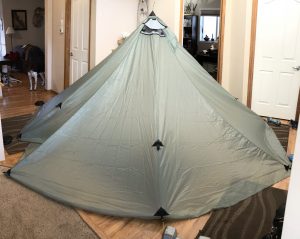
- Do a trial set-up in controlled conditions (a good idea with any tent). The tent comes with pieces of cord that need a loop tied to them and finagled through the pieces of plastic on the stake-out points. Best done indoors, and not on a windy hillside somewhere with your fingers freezing.
The stove, mostly the chimney, needs a break in (by burning a fire in the stove, so the metal will heat-set). First-time rolling of the chimney is best done with a few people and a piece of PVC pipe as a mold. I’ve seen video of a guy trying to do this alone in the field, and the result was a severely mangled chimney pipe. After the first burn the metal will have a tendency to pop back to the shape it was in under heat.
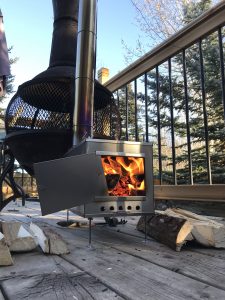
Staking the tent fabric close to the ground requires that you keep the loop in the cords as close to the tent as possible, with the stakes hammered in at an angle. The shape of the tent causes an upwards pull on the loops, which you can counter by having the stakes in at, say, a 60 degree angle. Then if you want to have ventilation space at the bottom, you can slide the loops up until they sit in the notches near the top of the stakes.
By the way, this tent has three guy-out loops, on the sides that do not contain the door, but it does not come with cord to do so, and it comes with only one extra tent stake surplus to the number of stake-out loops on the bottom, so you’ll need to buy two more stakes or rely on vegetation or rocks.
Do NOT hammer in the stakes too deeply if you are dealing with frozen ground, or you’ll have a heck of a time getting them back out. - The carbon pole is a four-piece affair, though it comes assembled as a three-piece. You can even manipulate it so in storage it is a two piece. Here is the danger. The springy thingies at the end of some of the pole segments, used to fasten the pieces together are not secured inside the poles! Innocuous as it may sound, if by improper handling you manage to push one or more of those things further into the pole sections, the metal protrusion doesn’t pop up anymore, and you cannot fit the pieces together! I got lucky that I hadn’t pushed them too deeply, or I’d have been hooped, or would have had to chop a sapling to size to get the tent set up. Now I got lucky and with a tiny stick I managed to push them back out. Of course these things always happen at -15 oC/5 oF and never during a summer’s day. So beware of those springy thingies, keep the protrusions popped up through the holes in storage, which may mean sticking with a 3 piece.
- Set up in the field was easy, with the previous practice in mind. Stake the corners, push up the pole, stake the remaining loops and guy-outs, all pretty simple (there was no wind). In a gale I can imagine this being a little harder. Stove assembly is fairly simple too, though fitting the rods through both holes (top and bottom of the stove) can be a bit tricky. Keep in mind that all this is simple in the backyard, with a beer to wash away any frustrations, but can become a major task after a long arduous hike in sub-zero weather. Try fitting a small wingnut on a threaded rod with mitts on, and you’ll understand.
- It wasn’t very windy, but there was a fair bit of movement and some creaking where the chimney meets the stove, and flapping of tent fabric whenever there was a breeze, so it will be interesting to see how this all behaves when the winds are up to 50 mph (not uncommon around here).
- Floorless. To floor or not to floor. I guess it depends on conditions and the type of trip. If you want a stove, you need a floorless, I assume, to prevent melting a hole in your tent? For argument’s sake, let’s say that is correct. If you are on a run and gun kind of trip, on the move all day till late at night, jumping in the tent just to fix a meal and sleep (and you don’t need a stove to keep you warm while sitting around), then a regular backpacking tent would be preferable. But if your are spending any amount of time in camp, going in and out of the tent regularly, or you are camping around the winter equinox with more hours of darkness than daylight, then the flexibility of the floorless tent with some headspace is nice to have. Keep your boots on when you walk in and out (walk, not crawl), a warm place to sit and read whiling away the long dark evening before bed time, it’s all very nice to have. If you are planning to hunt out of a fixed location where you’ll be returning every night, the little extra weight of the tent/stove combo is definitely worth it. If you run into weather, like days of rain on end, it seems like a no-brainer that the comfort of this set-up compared to holing up into a small one-person tent can make the difference between going home and staying out. Throw a dog into the mix, and the choice is clear. No risk of nails puncturing the tent bottom, no muddy paws all over your stuff. Provided you have taught him the difference between a sleeping bag and the dog blanket. Mine is a work in progress in that respect.
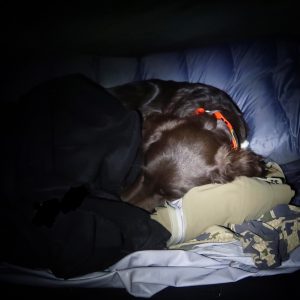
- Condensation and bugs, the big issues. Unfortunately I will have to defer judgement on those. At -15 oC there are no bugs to worry about, and any moisture in the air does not turn to droplets on the tent’s inner, but it freezes. Clearly there could be moisture issues. During the night I could see a layer of frost build up on the fabric above me. However, this disappeared quickly whenever the stove was going. That said, the bottom foot of fabric was never ice-free. Heat rises and the outside bottom edge is pretty far removed from the source of heat. It will be interesting to see how this will pan out during humid but above-freezing conditions. Keep in mind that this tent was purpose-bought for the mission, which is early and late season hunting or exploration, and that it is unlikely that I will use it without the stove, which should keep condensation issues to a minimum. Ask me again in six months or so.
- This tent has a huge footprint for a two-person shelter. I know it is claimed that four guys can sleep in this (with their gear outside). You can probably fit 5 or 6 in there if you really wanted to, but for comfort (which is where we started out), I’d say that two persons, and one gun dog, with room for gear, stove and firewood is about as good as it gets. See comment above about the ice build up on the bottom. I’d not want my fancy down sleeping bag to be rubbing on all that ice, and subsequently get wet, so the effective footprint is a little smaller. You can stuff some non-temperature sensitive gear closer to the edges I guess, but given that everything you put there will freeze, keep things more centralized could be advisable. For me and my hunting puppy this is a little palace, and over time we’ll figure out the optimal configuration of who lies where. E.g. putting a puppy that likes to chew on sticks next to the stack of fire wood, when you are trying to sleep, is not a good idea.
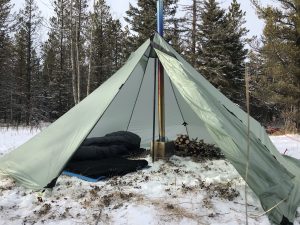
- Running the stove to provide a steady temperature level inside may require a bit of practice, and may require manipulating damping controls in the door and chimney and size of wood used, considering also the dryness of your fuel, the amount of ventilation you have going, and so forth. Also note that this thing has no thermal mass to speak off, so when the fire dies down, the temperature drops rapidly.
- I have yet to discover how best to transport the stove in a backpack. The tent is easy enough as it folds and rolls up and fits into a shapeless bag that you can stuff anywhere. The stove is made of awkwardly rectangular panels and the pipe, even rolled up sideways, has some bulk. The sheet metal is thin enough that I suspect you don’t want to crush it too much with compressions straps common on most backpacks. For this first trip I strapped it to the outside of my pack, where it covers up two external pockets, and gets undone every time I need to be in the main bag. Something I need to work on. If anybody has experience with transporting these things I am open to suggestions.
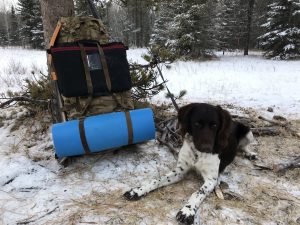
- Cooking: I trusted my ability to get a fire going (got lucky, threw in a spare lighter and wouldn’t you know it, the main lighter wouldn’t fire!), and did not bring a gas burner, just a billy pot to put on the flat upper of the stove. While a little slower than a Pocket Rocket or Jetboil, you can boil water reliably, or endeavour more challenging culinary experiments. Remember though that you’re not supposed to do that in your tent in grizzly country. And grizz stay out a lot longer than you think. Just because we had a few frosts and some snow doesn’t mean that they are all hibernating.
- The verdict: would I buy it again, knowing what I know now? It’s perhaps a little early to tell. It got me out on a weekend that was cold enough to keep me from overnighting with regular gear, so that’s a win. Set up on flat ground is easy enough; stove transport a little awkward until I learn a better way. You can stay warm and dry out gear in cold and wet conditions. Unproven (by personal experience) as yet in the wind. It’s a fantastic shelter if you are bringing a dog. It has a lot going for it therefore. At US$ 929 plus shipping it is not a cheap proposition, but then lightweight comfort in the backcountry seldom is. It may just be the ticket to keep these aging bones going to the mountains a little longer. What would make it really perfect would be one those small folding chairs. Ah, the luxury of leaning back, stretching the legs, putting another mini-log on the fire, taking a swig from the hip flask, admiring the wet-steaming dog that pointed those coveys of ptarmigan, while the weather outside is taking a turn for the worse… wait, that might be next year’s adventure.
DISCLAIMER: All experiences listed above are based on two set ups, of which one in the backyard, and a grand total of 15 hours in the tent (5pm till 8am).
FD
Excellent and enchanting review read. I ha e no intetest in a tent with fire (yet) but I really enjoyed the write up.
Thanks Lee!
I have spent the night in a “teepee tent” in the late fall. Not quite as light as yours and perhaps a little larger. Certainly comfortable. One of those little heat powered fans sitting on the stove does a nice job of circulating the heat, but something else to carry.
One thing to watch if you have been running the fire for a while is the creosote build up in those small diameter chimneys. My friend had the joy of the black, gooey stuff running down and onto his stove. I imagine if he had kept the fire a bit hotter it may have been avoided or at least mitigated.
We sat out a light snowstorm. It was nice to warm up the water for some hot buttered rum drinks while we sat in comfort and talked.
I understand that the choice of fuel has an influence on the creosote build-up as well. But generally, the fire gets pretty hot.